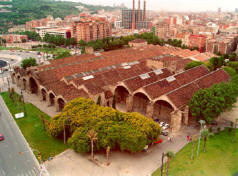The center for medieval fleets in the Mediterranean was the naval arsenal (Latin: tarsinatūs Catalan: drassanes, Castilan: atarazanas).
The arsenal was an essential focal point for the fleet, both in preparing the fleet for the sailing
season and for when the fleet was laid up at the end of the season, usually the end of September. It served as a store house for rigging, supplies and arms, as
usually the end of September. It served as a store house for rigging, supplies and arms, as well as the site for construction or repair of galleys.
well as the site for construction or repair of galleys.
One of the best examples of a medieval naval arsenal still in existence is the Museu
Maritím at Barcelona. Click this link to see a
plan and history of the Arsenal and a picture of it from space. Typical of
the arsenals of the period, it is made of a series of long sheds under which the
galleys could be stored and repaired. The arsenal at Barcelona was first
mentioned in 1255 and from then it was continually expanded and modified into
the 18th century. Muntaner in his chronicle believed the proper arsenal should
be able to house 20 galleys. Naval arsenals came in a variety of sizes, but virtually every outpost of a major Mediterranean city-state had one. The sheds were important, not only for protecting
the shipwrights and workers, but also for preventing fresh water collecting in
the vessels which could lead to dry rot. During the War of the Sicilian Vespers
the main arsenals for the Crown of Aragon were at Barcelona, Palermo and
virtually every outpost of a major Mediterranean city-state had one. The sheds were important, not only for protecting
the shipwrights and workers, but also for preventing fresh water collecting in
the vessels which could lead to dry rot. During the War of the Sicilian Vespers
the main arsenals for the Crown of Aragon were at Barcelona, Palermo and Messina, though the crown operated arsenals at other locations. During the war
the Messina arsenal was the mustering point for fleet's operations. The main Angevin arsenals were located at Marseilles, Naples and Brindisi.
Messina, though the crown operated arsenals at other locations. During the war
the Messina arsenal was the mustering point for fleet's operations. The main Angevin arsenals were located at Marseilles, Naples and Brindisi.
Besides building, repairing and storing the fleet's galleys, an arsenal had to also produce a prodigious quantity of arms and food. In 1289 the Messina arsenal bought or manufactured 142,000 crossbow bolts, produced approximately 460 metric tons of biscuit and used over 3 kilometers of canvas to make sacks in which to store the biscuit. To keep track of the vast quantities of material each arsenal had at least a magister and 2 notaries assigned by the Office of the Admiral to oversee the operations.

